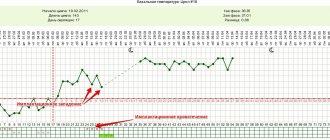The advent of ultrasound diagnostics has made it possible to observe the intrauterine life of the fetus. Expectant mothers are required to undergo this study three times as part of screening in each trimester of pregnancy. In the first and second trimester, the significance of markers of genetic pathology in the fetus is additionally determined; in later stages, this examination is not informative. Therefore, 3rd trimester screening consists primarily of ultrasound examination. What questions can ultrasound screening in the 3rd trimester answer?
What are the goals of the third screening?
The third screening during pregnancy helps to identify congenital abnormalities of the fetus that were not visible during the first two examinations. With its help, the baby’s development is assessed and pathology is diagnosed:
- intrauterine growth retardation;
- disruption of uteroplacental blood flow;
- hemolytic disease of newborns;
- signs of intrauterine infection;
- entanglement of the umbilical cord around the fetal neck;
- premature aging of the placenta;
- placenta previa;
- polyhydramnios and oligohydramnios;
- shortening of the cervix, etc.
Ultrasound in the third trimester describes the position of the fetus in the uterus, the condition of the postoperative scar on the uterus, the size of the fetus and other points that are decisive for the choice of delivery method: natural or cesarean section. This is the last examination during pregnancy. Its results summarize and complement previous ones in case of questionable or insufficient data in past studies.
Assessment of the functional state of the fetus
In addition to studying the structure of the fetal body, its vital parameters, such as heartbeat and breathing, should be determined. When the time comes for the third screening, the normal heart rate lies in the range of 110-150 beats/min. Low heart rate values (less than 100 beats/min) are dangerous. This may indicate the presence of congenital defects of cardiovascular structures.
The baby's breathing at 32-33 weeks of pregnancy should be rhythmic and correct. It should be carried out evenly with the help of the respiratory muscles under the control of the nervous structures. The normal rate (RR) corresponds to 30-70 respiratory movements per minute . The following pathological conditions of the respiratory system are possible:
- increase in RR more than 100/min;
- decrease in RR less than 15/min;
- apnea is the absence of respiratory movements, in which the fetal chest pathologically expands.
Each of them indicates a complicated course of pregnancy, when fetal hypoxia increases. An additional sign is the presence of convulsive movements of the child during ultrasound examination.
In some cases, doplerometry of the uteroplacental circulation and the fetal blood vessels themselves are done. This allows you to assess the presence of ischemia (insufficient blood flow) in a child and promptly select the correct treatment tactics.
Who needs to undergo the third screening
3 screening during pregnancy is recommended for absolutely all pregnant women, without exception. Particular attention should be paid when:
- pregnant woman over 35 years of age;
- poor or questionable results of two previous examinations;
- premature birth, intrauterine fetal death in previous pregnancies;
- the presence of genetic pathology in fetuses/children from previous pregnancies;
- infectious diseases during pregnancy;
- taking prohibited medications;
- presence of bad habits;
- working under difficult or harmful working conditions.
What is included in the third screening and when is it carried out?
Third trimester screening includes ultrasound, cardiotocography, and possibly biochemical screening. Doppler testing as part of screening is not performed in all pregnant women and strictly according to indications. The ultrasound method is the main examination; its results are compared with accepted standards and correlated with data from previous studies, on the basis of which conclusions are drawn.
The third screening during pregnancy has vague timing. They range from 30 to 37 weeks and are determined individually in each case.
- In a normal pregnancy, the period for performing an ultrasound in the 3rd trimester is 32-34 weeks of pregnancy.
- Doppler testing can be done on any day of the 3rd trimester.
- It is advisable to start recording cardiotocography from 28-30 weeks with the frequency required in a particular case.
Decoding the results
Based on the findings of ultrasound, Dopplerography, CTG and biochemical tests, the doctor makes a comparison with standard values and assesses the likelihood of abnormalities in the child’s development. It's not just what individual types of research show that play a role. The entire range of results is taken into account.
Based on an assessment of all indicators of the third screening, the risk of chromosomal abnormalities in the fetus is calculated. It is expressed in the form of a proportion of 1:1000 relative to several genetic pathologies. If the value does not exceed 1:380, it is considered that the probability of violations is low.
Factors influencing screening results
The objectivity of the results of examinations included in the mandatory third screening can be affected by many factors, including indigestion on the day of taking the tests and the consequences of non-compliance with the rules for taking them (for example, having breakfast before taking a blood test).
The patient's anxiety during the scan and being in a state of stress can distort the results.
To reduce the influence of external components, it is recommended to follow the advice of your doctor, follow the prescribed diet and be less nervous.
What can be seen on the third ultrasound
Ultrasound allows you to assess the condition of the mother’s reproductive organs and the development of the baby. An ultrasound technician describes:
- position (longitudinal, transverse, oblique) and presentation of the fetus in the uterus (cephalic, pelvic);
- estimated fetal weight;
- fetal dimensions (fronto-occipital size, biparietal head size, abdominal circumference, chest circumference, length of the femur and other tubular bones according to indications);
- internal organs, skeleton and brain of the fetus;
- placenta (thickness, maturity, attachment);
- umbilical cord (normally there are 3 vessels in the umbilical cord: 2 arteries and 1 vein);
- the presence of an umbilical cord entwined around the fetal neck;
- amount of amniotic fluid (amniotic fluid index);
- uterus and appendages;
- length of the cervix and cervical canal.
Norms
To decipher the results of the third screening, you need to know the norms of ultrasound, Doppler, CHT and blood biochemistry. Deviations from them will indicate certain pregnancy problems.
Ultrasound
1. Condition of the placenta
- It is located close to the fundus of the uterus, but not too low.
2. Amount of amniotic fluid
3. Fetometry (fetal size)
BPR - biparenial size, DB - thigh length, OG - head circumference.
Doppler
1. Uterine blood flow
To determine the speed of blood flow in the vessels of the uterus, a parameter called the resistance index (RI) is used, it is calculated by the formula: IR = (SSK - DSB)/SSK, where RSB is the systolic blood flow velocity (maximum), and DSB is the diastolic (final).
2. Cord blood flow
CTG
Assessment of a child's cardiac activity
- 8-10 points - normal fetal condition.
- 5-7 points - initial signs of hypoxia.
- Less than 4 points - serious pathologies.
Blood biochemistry
- HCG: In the third trimester, the normal level ranges from 2,700 to 78,100 mIU/ml.
- AFP: at 28 weeks - from 52 to 140, at 29-30 weeks - from 67 to 150, at 31-32 weeks - from 100 to 250, further analysis is not carried out due to low information content.
- Placental lactogen: 28-30 weeks - 2-8.5 mg/l, 31-34 weeks - 3.2-10.1 mg/l, 35-38 weeks - 4-11.2 mg/l, 39-44 week - 4.4-11.7 mg/l.
The results of the third screening are complex indicators that are calculated using special formulas using medical terminology. In this regard, parents should not decipher them themselves. The doctor must explain everything in detail, which indicators correspond to the norms, and where there are deviations and what this means for the mother, the baby and the upcoming birth.
What can Doppler measurements and cardiotocography tell you?
Doppler examination of the vessels of the mother and fetus allows us to assess the uteroplacental circulation. By comparing the data obtained for the two uterine, umbilical and spinal arteries with standard indicators, one can indirectly judge the supply of oxygen and nutrients to the fetus. Indications for Doppler examination are:
- arterial hypertension, anemia, diabetes mellitus, heart disease and other organs in the expectant mother;
- complicated course of previous pregnancies;
- gestosis;
- oligohydramnios;
- single umbilical cord artery;
- intrauterine growth retardation;
- premature aging of the placenta;
- multiple pregnancy.
Cardiotocography is a simultaneous recording in the form of a graph of changes in the fetal heartbeat and uterine tone over a certain period of time. Fetal movements can also be recorded and the dependence of heart rate variability on fetal movements can be assessed. CTG results will help determine whether the fetus has hypoxia.
False results
The third screening includes a set of examinations that should give an idea of the final prenatal picture of pregnancy. There are several conditions that can distort the objectivity of the results. Factors leading to false indicators include:
- multiple pregnancies due to the difficulty of considering each baby individually;
- conception performed using the method of in vitro fertilization;
- incorrectly determined gestational age, which causes errors in determining whether development corresponds to the norm;
- the patient is overweight or underweight;
- diagnosed diabetes mellitus.
How is the third screening performed?
Ultrasound of the third trimester of pregnancy and Doppler testing are performed while lying on your back. The sensor is placed on the abdomen using a special gel. No preparation is required before the examination.
Cardiotocography is performed while lying on your back, on your side and sitting. Considering that the procedure requires a lot of time (up to 40 minutes), lying on the stomach can be difficult due to the manifestation of superior vena cava syndrome. In this case, the examination is carried out lying on the left side or sitting. Two sensors are used:
- one is for recording fluctuations in the timing of the fetal heartbeat;
- the second is for recording uterine activity.
No special preparation is required. However, to stimulate the motor activity of the fetus, you can have a sweet snack with you in the form of a banana, chocolate or a candy bar.
Preparation and performance of 3 ultrasound scans during pregnancy
To obtain reliable test results, a pregnant woman should prepare for diagnosis in advance. 2 days before the procedure, exclude from the diet foods that cause increased gas formation - legumes, cabbage, fresh fruits, baked goods, sweet carbonated drinks, fresh milk. You need to thoroughly clean the external genitalia, have shoe covers, a diaper and a towel with you.
To perform the last planned ultrasonography, an abdominal sensor is used; the expectant mother should take a comfortable position on the couch and listen to the comments of the sonologist










